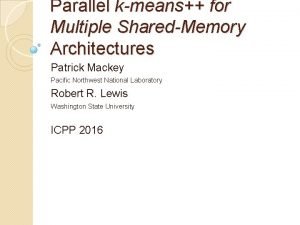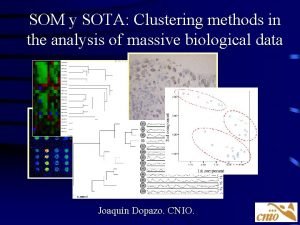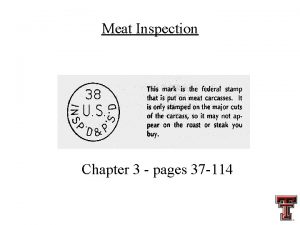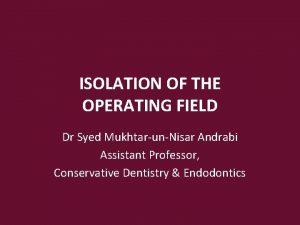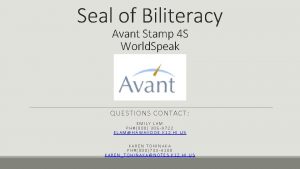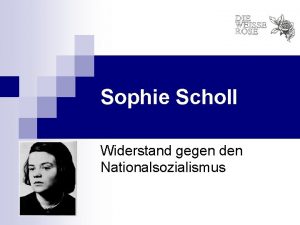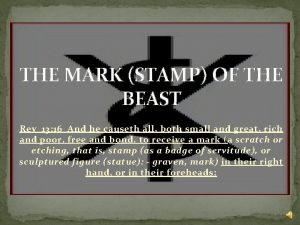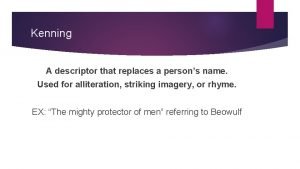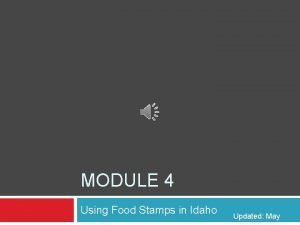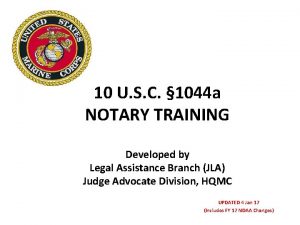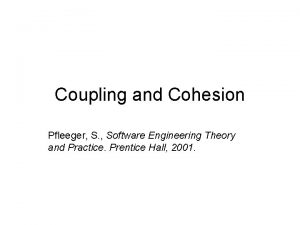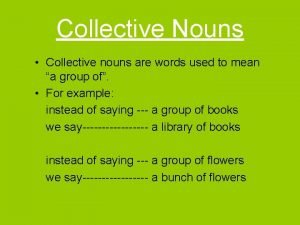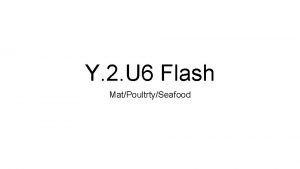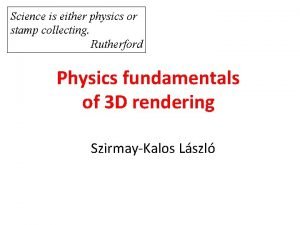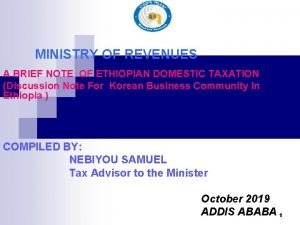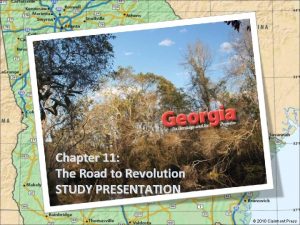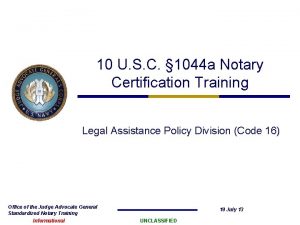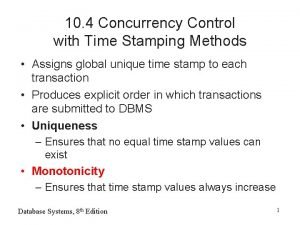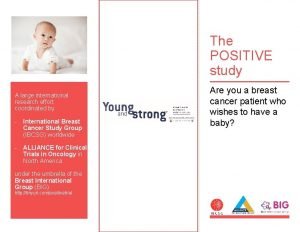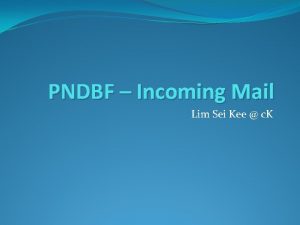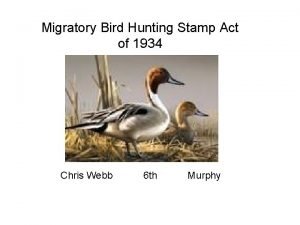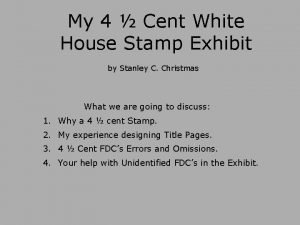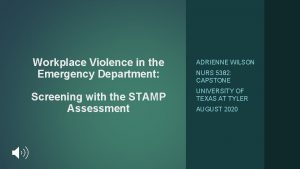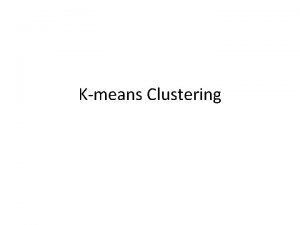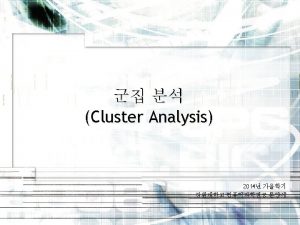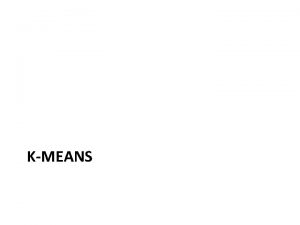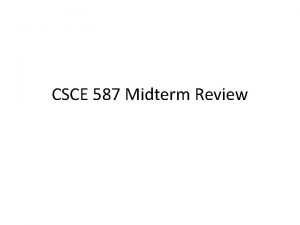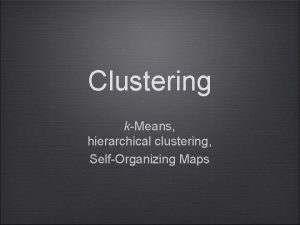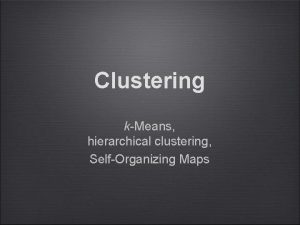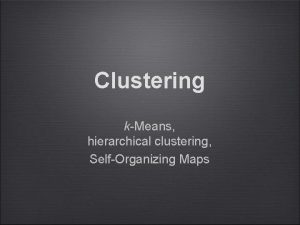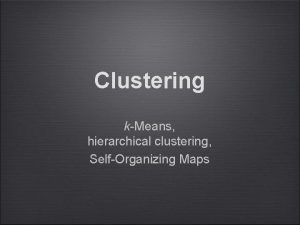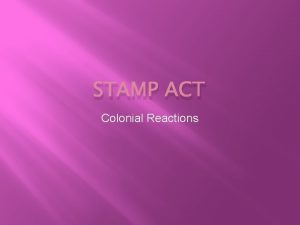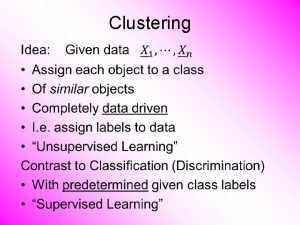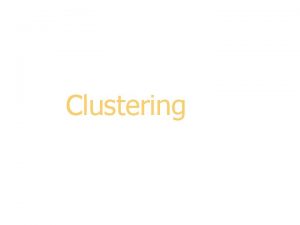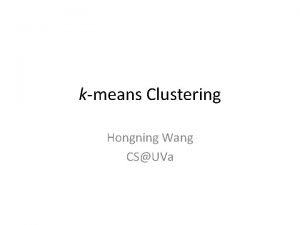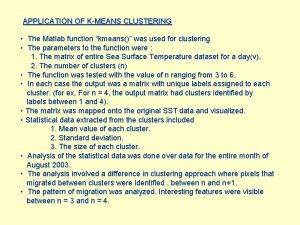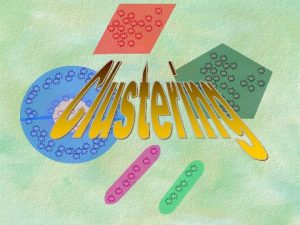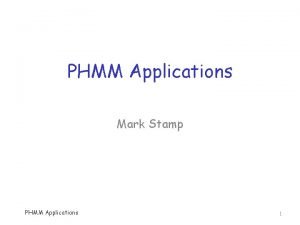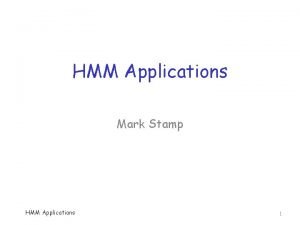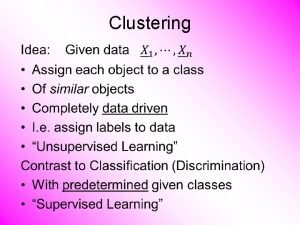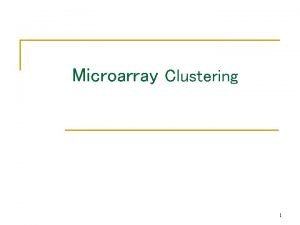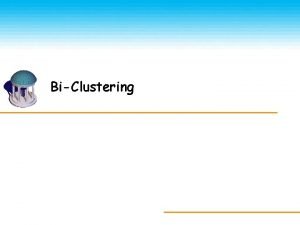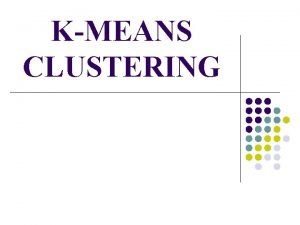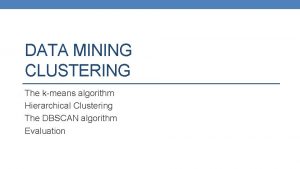Clustering Applications Mark Stamp Clustering Applications 1 KMeans













































- Slides: 45

Clustering Applications Mark Stamp Clustering Applications 1

K-Means for Malware Classification Chinmayee Annachhatre Mark Stamp Clustering Applications 2

Quest for the Holy Grail q Holy Grail of malware research is to detect previously unseen malware o So-called “zero day” malware q If you solve this problem, you’ll be rich q We don’t consider this problem here q But we do consider something similar q Problem here… classify “new” malware o New in a sense… Clustering Applications 3

Motivation q Can we automatically classify malware? o Using only HMM scores q Train HMMs for several compilers and metamorphic generators q Then cluster malware based on scores q Note that the clustered malware does not correspond to any of the HMMs o Why not model clustered families? Clustering Applications 4

Related Work q Previous work on metamorphic detection using HMMs q Other work showed HMMs can identify the compiler used o Not too surprising, since metamorphic generator is a type of “compiler” q Here, we extend these results to malware classification problem Clustering Applications 5

Malware Classification q Some examples of previous work o Structured control flow call graphs or other graph structures o Behavioral analysis dynamic analysis o Data mining methods n-gram analysis using Naïve Bayes, SVM, etc. o VILO feature vectors (n-grams), TFIDF weighting, nearest neighbor Clustering Applications 6

Implementation q Next, consider implementation details related to each of the following o o Training HMMs Malware dataset Scoring Clustering q Then we discuss experimental results Clustering Applications 7

Training HMMs q Train HMM for each of the following… q Four compilers o GCC, Min. GW, Turbo. C, Clang q Hand-written assembly code o We refer to this model as TASM q Two metamorphic families o NGVCK and MWOR Clustering Applications 8

HMMs q Previous work has shown that HMMs effective at detecting compiler o Based on opcodes q Implies that each compiler has a distinctive statistical profile q Previous work included TASM, NGVCK, and MWOR for comparison o Here we apply models to other malware Clustering Applications 9

HMMs q NGVCK o Next Generation Virus Construction Kit o Highly metamorphic o Studied in lots of previous research q MWOR o Experimental metamorphic generator o Designed to be “stealthy” wrt statistical analysis Clustering Applications 10

HMMs q Number of files used for training Clustering Applications 11

Malware Dataset q Malicia Project website q Contains 11, 688 malware samples o Collected from 500 drive-by download servers for 11 months beginning in 2012 o An exe or dll file is available for each o Limited metadata provided o For most, a family name provided o More details in a little bit… Clustering Applications 12

Scoring q For each malware sample under consideration… q Score sample with each of 7 models o GCC, Clang, Turbo. C, Min. GW, TASM, NGVCK, MWOR q Each score is normalized (LLPO) q For each malware sample, obtain a vector of 7 (normalized) HMM scores Clustering Applications 13

Clustering Details q Suppose we have N malware samples, m 1, m 2, …, m. N q Suppose score vector for mi is (ai, bi, ci, di, ei, fi, gi) q Let amin = min{ai} and amax = max{ai} q Given K, the number of cluster o Let a = (amax – amin) / (K+1) q Define b, c, d, e, f, g similarly Clustering Applications 14

Initial Centroids q For j = 1, 2, …, K define initial centroids Cj = (amin + j a, bmin + j b, …, gmin + j g) q Note that we have divided each range into equal-sized segments q Uniformly spaced initial centroids q Once initial centroids are computed, samples clustered to nearest centroid Clustering Applications 15

Update Centroids q Suppose cluster j has n malware samples q Denote these samples as m 1, m 2, …, mn q Then the scores are given by Clustering Applications 16

Update Centroids q Let amean = (a 1 + a 2 + … + an) / n o And similarly for bmean, cmean, …, gmean q Then the new centroid is Cj = (amean, bmean, cmean, …, gmean ) q And thus the name, K-means Clustering Applications 17

Update Clusters q After all K centroids computed… q Regroup malware samples, based on nearest centroid q Recompute centroids (as on previous slide) and regroup… q Continue until no significant change occurs when regrouping q Definition of K-means clustering!!! Clustering Applications 18

Experimental Setup q Host and virtual (guest) machine o Why use a virtual machine? q Host: Sony Vaio T 15, Intel i 5 -3337 U (1. 8 GHz), 400 GB RAM Windows 8 o All processing not involving malware q Guest: Oracle Virtual. Box VM (1 GB), Ubuntu 12. 04. 3 LTS o For dealing directly with malware Clustering Applications 19

Malware Families metadata q We focus on the 3 dominant families q From o Winwebsec fake AV o Zbot information stealing Trojan o Zeroaccess Trojan that installs rootkit Clustering Applications 20

Experiments q Performed clustering, K = 2 to K = 15 q Results on next slides… o Using all 7 scores o Uniform initial centroids o And N = 2 hidden states in all HMMs q Also experimented with o Combinations of 7 (or less) scores, uniform vs random initial centroid, N in HMMs, … Clustering Applications 21

Measuring Success q Can we quantify the quality of results? q Ideally, each cluster should include only one family (i. e. , one color) o Here, we focus on 3 dominant families o Winwebsec, Zbot, Zeroaccess q How to measure this? Clustering Applications 22

Measuring Success Let C 1, C 2, …, Ck be final the clusters q Let q xi = number of Winwebsec in Ci yi = number of Zbot in Ci zi = number of Zeroaccess in Ci Mi = max{xi, yi, zi} q Then define score = (M 1 + M 2 + … + Mk) / T o Where T is total of Winwebsec, Zbot, and Zeroaccess files o Note that T = 7803 from previous table Clustering Applications 23

Measuring Success q Recall, score = (M 1 + M 2 + … + Mk) / T o Note that 0 < score ≤ 1 o And, score = 1 implies all clusters are uniform (wrt 3 major families) q Suppose we classify simply based on dominant family in a cluster q Then score = 1 is a perfect result o Wrt the three major families Clustering Applications 24

Heat Map Top is binary vector of scores used q Left is number of clusters, K = 2 to K = 15 Color: Blue = weak, Yellow = medium, Red = best q Clustering Applications 25

Heat Map q 7 -tuple of scores o GCC, Min. GW, Turbo. C, Clang, TASM, MWOR, NGVCK q Observations… o Best score is ≈ 0. 82 o Need 6 or more clusters for best results o Do not need to use all of the HMM scores q So, is 0. 82 good or not? q Better than “random” classification? Clustering Applications 26

Clusters for Classification q Our “score” is accuracy if we classify based on dominant type in cluster o That is, score samples of unknown type by clustering to nearest centroid o And classify by dominant type in cluster q Previous slide says we can get more than 0. 82 correct in this manner q Good? Bad? Compared to what? Clustering Applications 27

Clusters for Classification q From o o previous table 4361 Winwebsec 2136 Zbot 1306 Zeroaccess Total of these three is 7803 q Suppose we expect to see only these 3 families, and at these rates q Can use expected number to “classify” Clustering Applications 28

Classification q Classifying based on expected number q Probability of success is about 0. 415 o Why? q So, classifying at 0. 82 is not too bad q Is this good enough to be of any use? o Much better than “random” o But how might we actually use it? Clustering Applications 29

Discussion q Here HMMs not specific to families q Results show we get decent results q Can expect to “classify” previously unseen malware at about these rates q How could this be useful? o Malware may be similar to that in cluster o So, possibly faster analysis/response q Also relevant to classification/naming Clustering Applications 30

Conclusion q HMM scoring scheme able to classify unrelated malware with good accuracy o Malware is unrelated to scores used q Not accurate enough for detection o Only 82% accuracy in this work q But, other potential uses o As an aid in analysis of new malware o As a tool for classification/naming Clustering Applications 31

Future Work q Other clustering techniques o K-mediods, fuzzy K-means, EM, etc. q Use additional malware-specific models q Other types of scores/scoring o Structural scores (entropy, compression, eigenvector-based, etc. ) o More advanced combinations of scores q Experiments Clustering Applications with other data sets 32

EM versus K-Means for Malware Analysis Swathi Pai Usha Narra Mark Stamp Clustering Applications 33

Clustering Malware q Again, focused on “new” malware q Can we detect/analyze previously unseen malware using clustering? q Compare K-means and EM clustering q Number of clusters varies from 2 to 10 q Number of models (i. e. , “dimensions”) varies from 2 to 5 q Analyze clusters vs dimensions Clustering Applications 34

Data and HMMs q Again use Malicia dataset q And again focus on the 3 main families o Zbot, Zeroaccess, Winwebsec q Train HMMs for each of these 3, plus NGVCK and Smart. HDD o We have 5 models in total q Then 5 HMM scores for each sample q Cluster based on (subsets of) scores Clustering Applications 35

Dimensions q “Dimension” is number of models used o 2 -d Winwebsec, Zbot o 3 -d Winwebsec, Zbot, and Zeroaccess o 4 -d Winwebsec, Zbot, Zeroaccess, and NGCVK o 5 -d Winwebsec, Zbot, Zeroaccess, NGCVK, and Smart. HDD q Why these subsets? o Why not? Clustering Applications 36

Cluster Quality q Use a simple purity-based measure o pij = mij / mj o Where mij is number of type i in cluster j o And mj is number of elements in cluster i q If sample x is in cluster Cj, then o scorei(x) = pij o That is, scorei(x) is proportion of data of type i in cluster that sample x belongs to Clustering Applications 37

Clustering Scores q Let i=0 correspond to Zbot q And i=1 correspond to Zeroaccess q And i=2 correspond to Winwebsec q If sample x is in cluster Cj, then o score 0(x) = Zbot score of x o score 1(x) = Zeroaccess score of x o score 2(x) = Winwebsec score of x Clustering Applications 38

Clustering Scores q ROC and AUC based on each of the 3 scores on previous slide q For example, we use score 0(x) to score all samples, where… o Zbot is match and all others are nomatch q Generate scatterplot and ROC curve o Compute AUC q Similarly Clustering Applications for score 1(x) and score 2(x) 39

Results q Based on AUC results Clustering Applications 40

More Results q Dimensions Clustering Applications vs number of clusters 41

Discussion q For K-means, number of clusters is important but dimension, not so much q For EM, both number of clusters and number of dimensions seem to matter o Dimension matters more in EM q And overall, EM is better o Generally expect EM to be at least as good, so, this is not too surprising Clustering Applications 42

Discussion q Zero-day malware is malware that has never been seen before o So, no signature is available o How to detect or analyze? q Results indicate that clustering might be useful for such malware q Reasonably accurate classification o Even when model does not match family Clustering Applications 43

References C. Annachhatre, Hidden Markov models for malware classification, Journal of Computer Virology and Hacking Techniques, 11(2): 5973, May 2015 q T. H. Austin, et al, Exploring hidden Markov models for virus analysis: A semantic approach, Proceedings of 46 th Hawaii International Conference on System Sciences (HICSS 46), January 7– 10, 2013 q Clustering Applications 44

References q S. Pai, et al, Clustering for malware classification, Journal of Computer Virology and Hacking Techniques, 13(4): 95– 107, May 2017 q U. Narra, et al, Clustering versus SVM for malware detection, Journal of Computer Virology and Hacking Techniques, 2(4): 213 -224, Nov. 2016 Clustering Applications 45
 Thrust kmeans
Thrust kmeans Sota algorithm
Sota algorithm Javascript kmeans
Javascript kmeans Flat clustering
Flat clustering Bond energy algorithm
Bond energy algorithm Flat clustering vs hierarchical clustering
Flat clustering vs hierarchical clustering Clustroid
Clustroid Boston tea party stamp
Boston tea party stamp Place stamp here
Place stamp here Pbasic programming
Pbasic programming Place stamp here
Place stamp here Clone stamp tool photoshop definition
Clone stamp tool photoshop definition Stamp
Stamp Why did the colonists resent the stamp act?
Why did the colonists resent the stamp act? On package
On package Rubber dam
Rubber dam The stamp tax uproar
The stamp tax uproar App.avantassessment.com
App.avantassessment.com Sophie scholl lebenslauf
Sophie scholl lebenslauf Pan african and independence comprehension check answers
Pan african and independence comprehension check answers The mark
The mark Land line kenning
Land line kenning Idaho quest card
Idaho quest card 10 u.s.c. 1044a notary stamp
10 u.s.c. 1044a notary stamp Bidstamp
Bidstamp Stamp coupling in software engineering
Stamp coupling in software engineering Collective noun of bees
Collective noun of bees Miss lawrence billie holiday
Miss lawrence billie holiday Meat is firmest when it is cooked how well?
Meat is firmest when it is cooked how well? Rutherford stamp collecting
Rutherford stamp collecting Kelsey fry technique ppt
Kelsey fry technique ppt Stamp duty(amendment) proclamation no. 612/2008
Stamp duty(amendment) proclamation no. 612/2008 Cdc stamp
Cdc stamp Sugar and stamp act
Sugar and stamp act 10 usc 1044a notary stamp
10 usc 1044a notary stamp Basic stamp ii
Basic stamp ii Time stamping in dbms
Time stamping in dbms Nanny shine
Nanny shine Place stamp here
Place stamp here Ca stamp format
Ca stamp format Incoming mail register
Incoming mail register Joe louis postage stamp
Joe louis postage stamp Migratory bird hunting stamp act
Migratory bird hunting stamp act 4 cent house
4 cent house Stamp violence assessment tool
Stamp violence assessment tool Sugar and stamp act
Sugar and stamp act
